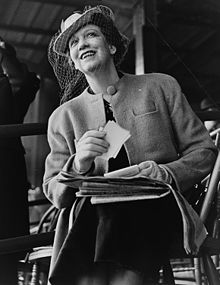Elizabeth Arden
Elizabeth Arden | |
|---|---|
 Elizabeth Arden (1939) | |
| Born | Florence Nightingale Graham December 31, 1878 |
| Died | October 18, 1966 (aged 87) |
| Occupation(s) | Businesswoman: Cosmetics Racehorse owner/breeder |
Florence Nightingale Graham (December 31, 1878 – October 18, 1966), who went by the business name Elizabeth Arden, was a Canadian-born American businesswoman who founded what is now Elizabeth Arden, Inc., and built a cosmetics empire in the United States. By 1929 she owned 150 upscale salons across the United States and Europe. Her 1000 products were found in the luxury market in 22 countries. She was the sole owner, and at the peak of her career, she was one of the wealthiest women in the world.
Biography
Arden was born in 1884 in Woodbridge, Ontario, Canada. Her parents had emigrated to Canada from Cornwall, United Kingdom in the 1870s. Her father, William Graham, was Scottish and her mother, Susan, was Cornish and had arranged for a wealthy aunt in Cornwall to pay for her children's education.[1] Arden dropped out of nursing school in Toronto.[2]
She then joined her elder brother in Manhattan, working briefly as a bookkeeper for the E.R. Squibb Pharmaceuticals Company. While there, Arden spent hours in their lab, learning about skincare. She then worked—again briefly—for Eleanor Adair, an early beauty culturist, as a "treatment girl".
In her salons and through her marketing campaigns, Elizabeth Arden stressed teaching women how to apply makeup, and pioneered such concepts as scientific formulation of cosmetics, beauty makeovers, and coordinating colors of eye, lip, and facial makeup.
Elizabeth Arden was largely responsible for establishing makeup as proper and appropriate—even necessary—for a ladylike image, when before makeup had often been associated with lower classes and prostitutes. She targeted middle age and plain women for whom beauty products promised a youthful, beautiful image. In politics, Elizabeth Arden was a strong conservative who supported Republicans.[3]
Career


In 1909, Arden formed a partnership with Elizabeth Hubbard, another culturist. The business relationship dissolved after six months. Graham, who desired a trade name, used "Elizabeth" to save money on her salon signage. She chose the last name, "Arden", from a nearby farm. So the trade name "Elizabeth Arden" was formed. From there, Arden founded, in 1910, the Red Door salon in New York, which has remained synonymous with her name ever since (see under Elizabeth Arden, Inc).[citation needed]
In 1912, Arden traveled to France to learn beauty and facial massage techniques used in the Paris beauty salons. She returned with a collection of rouges and tinted powders she had created. She began expanding her international operations in 1915, and started opening salons across the world. In 1934, she opened the Maine Chance residential spa in Rome, Maine, the first destination beauty spa in the United States. It operated until 1970.[4]
In 1962, the French government awarded Arden the Légion d'Honneur, in recognition of her contribution to the cosmetics industry.[citation needed]
In 1966, Arden died at Lenox Hill Hospital in Manhattan. She was interred in the Sleepy Hollow Cemetery in Sleepy Hollow, New York, under the name Elizabeth N. Graham.[citation needed]
References
- ^ Sawyers, June Skinner (1966). Famous Firsts of Scottish-Americans. Pelican Publishing, p. 11.
- ^ Davidson, Hilary. Frommer's Guide to Toronto 2004. p. 262. ISBN 0-7645-4060-2.
- ^ Lewis, Jone Johnson (2015). "Elizabeth Arden Biography". Retrieved 2015-04-07.
- ^ McMillan, Susan (June 13, 2014). "Former Elizabeth Arden estate on Long Pond for sale". Kennebec Journal. Augusta, Maine. Retrieved 2014-06-13.
War Paint by Lindy Woodhead page 94
Further reading
- Haag, Karin Loewen (1999). "Arden, Elizabeth". In Commire, Anne (ed.). Women in World History: A biographical encyclopedia. Vol. 1. Waterford, CT: Yorkin Publications, Gale Group. pp. 442–446. ISBN 0787640808.
- Marshall, Mary. Great Breeders and Their Methods (2008) Russell Meerdink Co. Ltd. ISBN 978-0-929346-82-3
- Peiss, Kathy. Hope in a jar: The making of America's beauty culture (University of Pennsylvania Press, 2011).
- Willett, Julie A. (2010). The American Beauty Industry Encyclopedia. ABC-CLIO. pp. 22–25.
- Woodhead, Lindy. War Paint (2004) Virago ISBN 1-84408-049-8
External links
- 1878 births
- 1966 deaths
- American cosmetics businesspeople
- American people of Cornish descent
- American people of English descent
- American people of Scottish descent
- American racehorse owners and breeders
- American women in business
- Burials at Sleepy Hollow Cemetery
- Businesspeople from Ontario
- Canadian emigrants to the United States
- Canadian Horse Racing Hall of Fame inductees
- Canadian people of Cornish descent
- Canadian people of English descent
- Canadian people of Scottish descent
- Cosmetics people
- History of cosmetics
- Légion d'honneur recipients
- People from Vaughan
